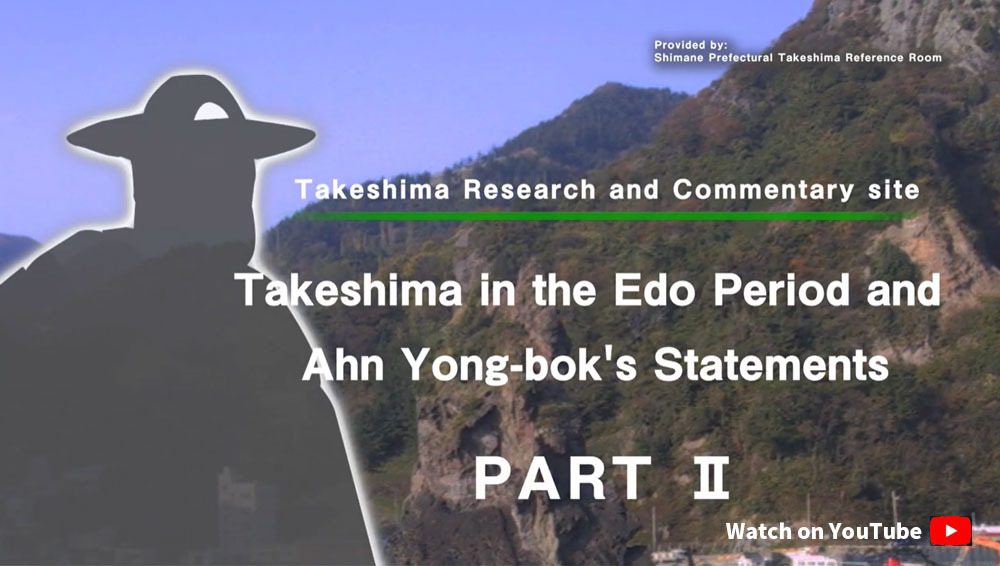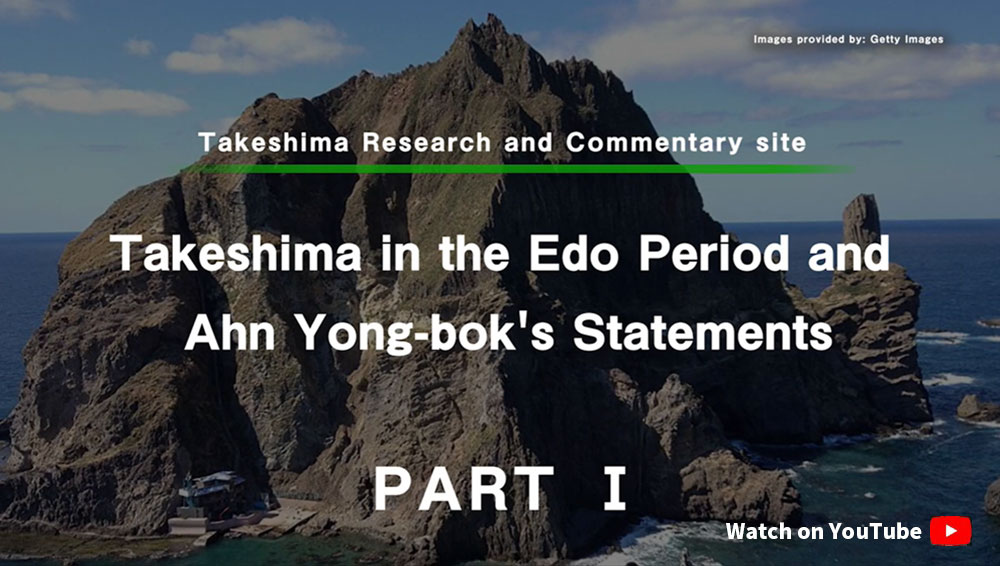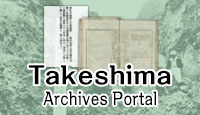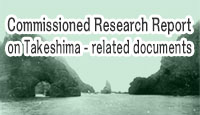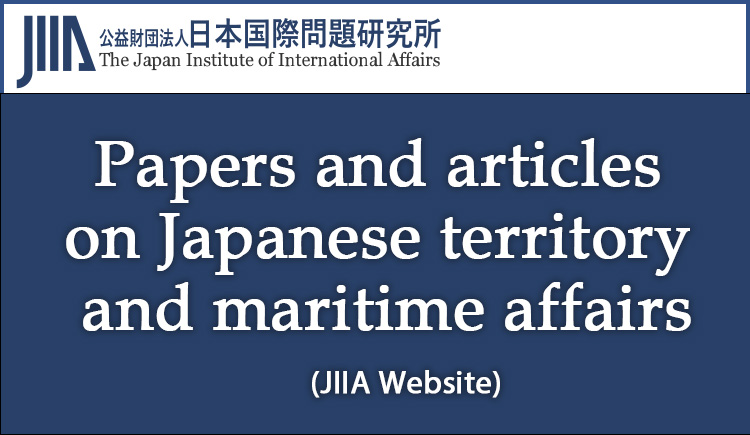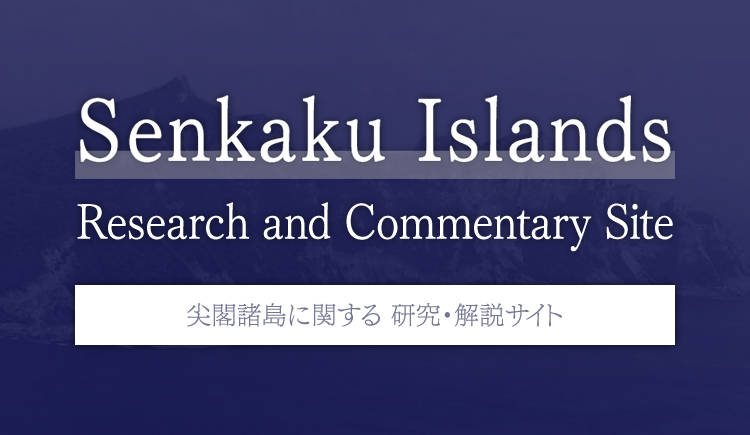The documents and materials published on this website were collected, researched, and prepared with advice from experts, as a part of a Government-commissioned project. The contents of this website do not reflect the views of the Government. Links to external sites (domains other than https://www.cas.go.jp) are not under the management of this site. For linked websites, please check with the organization/group that manages the website for the link in question.
Commentary on themes by historical period
Classification by historical periods I
After the OYA family and
MURAKAWA family began traveling to Utsuryo Island and Takeshima with permission from the shogunate
(Edo era)
(2) Understanding of Takeshima
Commentary Video Takeshima in the Edo Period and Ahn Yong-bok's Statements Part 2
Play time / 00:13:00 Youtube
Overview
These videos introduce historical background on Takeshima, including the fact that, for most of the
17th Century, Japanese merchants called the Oya and Murakawa families (from Yonago in Tottori Domain),
traveled to Utsuryo Island every year and used Takeshima as a docking point and as a hunting and fishing
ground for sea lions and abalone. Furthermore, the videos make clear the reasons why the statements of
Ahn Yong-bok (*1) do not support the Government of the ROK’s territorial claim on Takeshima
despite the
ROK’s assertion otherwise.
Part 1 describes how Takeshima became known widely to the people of Japan in the Edo Period by
introducing various historical details on the Oya and Murakawa families’ business travels to Utsuryo
Island and Takeshima, including the fact that their joint enterprise started in 1618 (*2) with the
permission of the Edo Shogunate to acquire various commodities in the islands and sell them in Japan.
Subsequently, the video explains in detail how a historical incident that happened in 1692 resulted in
the prohibition of the two families’ passage to Utsuryo Island; when a Murakawa family’s ship arrived at
Utsuryo Island that year, they encountered a number of Korean fishermen and were unable to fish, and the
situation was the same in the following year when an Oya family’s ship traveled to Utsuryo Island. As
the Shogunate had ordered the Oya family to acquire certain products including abalone on the island,
they decided to take two Korean fishermen, Ahn Yong-bok and Pak Eo-doon, to Japan as proof of why
they could not fulfill the order (the Korean fishermen were subsequently repatriated to Korea.) Then,
the Shogunate initiated negotiations with Korea via Tsushima Domain, requesting that Korea prohibit its
people from traveling to Utsuryo Island. However, the negotiations did not go well, and in January 1696,
in an effort to maintain friendly relations with Korea, the Shogunate decided to prohibit the Oya and
Murakawa families from traveling to Utsuryo Island. Meanwhile, traveling to Takeshima was not
prohibited.
Part 2 demonstrates why the Government of the ROK’s territorial claim on Takeshima, based on the
statements made by Ahn Yong-bok, is completely groundless. Ahn Yong-bok appeared on the
Oki Islands in May 1696, seeking to “make a claim against the Tottori Domain.” After being interrogated
by local government officials in the Islands, he was moved to Tottori Domain, only to be expelled on the
orders of the Shogunate. After returning to Korea, Ahn Yong-bok was apprehended by the governor
of Gangwon Province, and interrogated by the Border Defense Council of Joseon (Bibyeonsa), an
organization tasked with the defense of Korea’s national borders. His statements to the Bibyeonsa are
recorded in the Annals of King Sukjong, the official record of the Korean royal dynasty.
According to the record, he made a false statement to the Bibyeonsa that he had had a chance to see the
Lord of Tottori Domain in Japan. He also told the Bibyeonsa that, in the non-existing meeting with the
Lord, he had claimed that Takeshima is a Korean island and had lodged a protest against the landing of
the Japanese on the island in spite of the Shogun’s promise not to allow Japanese people to travel to
the island (He argued he had obtained the promise in his first visit to Japan). Moreover, he asserted
that the Lord of Tottori Domain had apologized to him and had committed that no Japanese person would
travel to Takeshima anymore. The Government of the ROK has based its unilateral territorial claim on
Takeshima on this official record, but most of Ahn Yong-bok’s statements in Bibyeonsa do not
match the Japanese records. The video compares and examines the records of Ahn Yong-bok’’s
statements made both on the Oki Islands and to the Bibyeonsa, and demonstrates that his statements to
the Bibyeonsa are totally lacking in credibility. The video also shows the fact that the Korean
government at the time disavowed Ahn Yong-bok’s claims in Japan and said so to the Japanese
Government via Tsushima Domain, which was the channel of communication to the Korean Government, thus
demonstrating that the assertions of the present-day Government of the ROK are groundless.
(*1) Ahn
Yong-bok was a Korean who traveled to Japan twice in the 17th century. In the ROK today, he is
considered a hero for purportedly asserting to Japan that Takeshima is Korean territory and supposedly
succeeding in getting Japan‘s acceptance. A monument has been built to honor his memory on Utsuryo
Island.
(*2) Some argue that permission was granted in 1625.
Related Video
Related Info.
Takeshima
Research and Commentary Website
- I Comprehensive issues
- II Commentary on themes by historical period
- III Analysis of claims by other countries

